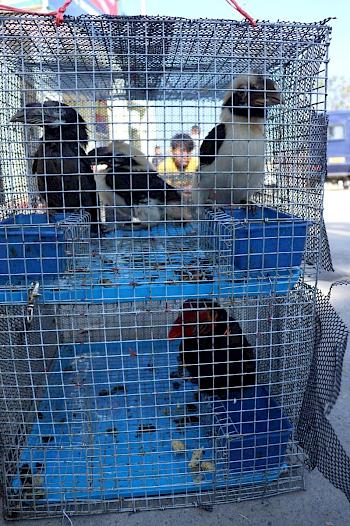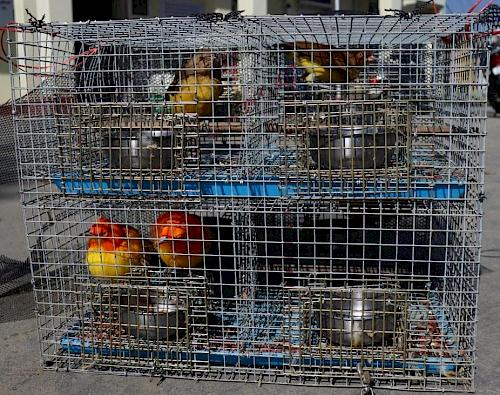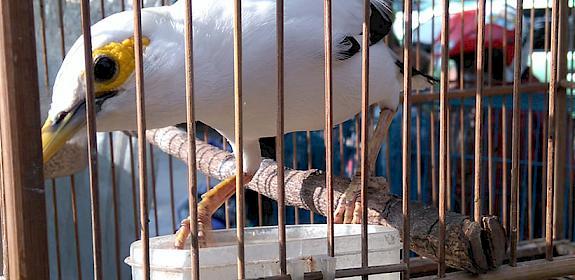Endemic Southeast Asian birds seized far from home raise questions
Native only to very specific parts of Southeast Asia, yet hornbills endemic to the Philippines and Bowerbirds found only in Indonesia and Papua New Guinea have turned up in a seizure thousands of miles away near the India-Myanmar border.
This unusual find was made by police in India’s state of Mizoram on 6 March while conducting random checks at Tualpui Junction on the Khawzawl to Rabung road, not far from the Myanmar border. The 17 animals seized from two suspects in a vehicle were believed to have been smuggled into India from Myanmar.

The seized hornbills and bowerbirds © Mizoram Police
The haul included 13 birds, among them are the Mindanao Tarictic Hornbill Penelopides affinis, Southern Philippine Rufous Hornbill Buceros mindanensis, Mindanao Writhed Hornbill Rhabdotorrhinus leucocephalus that are endemic to the Philippines, and Flame Bowerbirds Sericulus ardens only found in Papua province in Indonesia and neighbouring Papua New Guinea. Four monkeys were also part of the same illegal consignment.
These hornbills are rarely seen even in their home range in the Mindanao faunal region. To find these hidden in a vehicle in a trafficking attempt in India is just shocking.”
Kanitha Krishnasamy, Director for TRAFFIC in Southeast Asia
Of the 59 recognised hornbill species in the world, 32 are found in Asia, and 11 are endemic to the Philippines. Famous for being among the most vocal birds in the forests, hornbills play an important role in an ecosystem as seed dispersers. Many hornbill species, especially island endemics, are naturally uncommon. These forest dwellers face a double threat of forest loss and poaching for illegal trade.

TRAFFIC’s monitoring over the past five years has recorded these three hornbill species in the Philippine online markets.
Though only the Mindanao Rufous Hornbill is classified as Endangered under the IUCN Red List of Threatened Species, all three species of hornbill found in the seizure are listed as threatened in the National List of Threatened Terrestrial Fauna of the Philippines. Violators face up to 2 years of imprisonment and/or a fine of PHP200,000 (USD3,646).
The brilliantly coloured Flame Bowerbird is protected under Indonesia’s laws, but international trade in this species is not regulated under CITES*. While the Flame Bowerbird has been recorded in Indonesian bird markets, they are not as widely observed in trade as other passerine species. They have been recorded in Europe – sought after by niche collectors.
But this is not the first time the Flame Bowerbird was seized in Mizoram – four were found there in an October 2022 seizure involving 140 smuggled wildlife, similarly believed to have been smuggled from Myanmar.
“The appearance of these birds in two recent cases is very concerning and raises questions about whether traffickers are now targeting them because of a new or specific demand from collectors of rare species in Asia,” said Krishnasamy.
Cases like this reinforce the value of long-term monitoring to keep a finger on the pulse and uncover new and emerging species entering illegal trade, so that necessary interventions with key stakeholders can be made.”
Kanitha Krishnasamy, Director for TRAFFIC in Southeast Asia

As a hotspot of bird diversity and endemic species, Southeast Asia has long been a source of illegally traded wild birds within the region and internationally, with what appears to be an active case of wild animal trafficking between Southeast and South Asia.
In India, the newly amended version of the Wildlife (Protection) Act, 1972, has internalised CITES Appendix I and II-listed species, making the trade of such species illegal. This amendment strengthens much-needed protection for non-native wildlife species entering India, but closer co-operation is critical to stemming illegal trade.
This case of cross-border trafficking in Mizoram speaks to the ever-expanding reach of bird traffickers and their growing networks. It also underlines the need for enforcement agencies in affected countries – either at the source, transit or destination - to share information on seizures for better tracking and greater vigilance along the trade chain.”
Merwyn Fernandes, Coordinator for TRAFFIC’s India Office
Mizoram has seen a few large-scale wildlife seizures featuring an array of species from around the globe. For instance, a seizure of over 400 animals last year included three-toed sloths that are found only in Central and South America, and pottos, a slow-moving primate in tropical Africa.
Notes:
*CITES: The Convention on International Trade in Endangered Species of Wild Fauna and Flora




